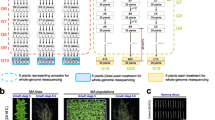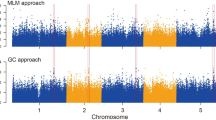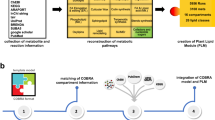Abstract
Understanding the mechanisms by which mutations affect fitness and the distribution of mutational effects are central goals in evolutionary biology. Mutation accumulation (MA) lines have long been an important tool for understanding the effect of new mutations on fitness, phenotypic variation, and mutational parameters. However, there is a clear gap in predicting the effect of specific new mutations to their effects on fitness. In an attempt to directly connect the effect of spontaneous mutations to their fitness effects, we quantified the metabolic expression of 386 known compounds in primary and secondary metabolism in Arabidopsis thaliana MA lines that had consistently higher and lower relative fitness than the progenitor. The high and low fitness lines do not have a difference in the average number of mutations and share the same types of metabolic pathways disrupted. However, compared to the progenitor, low fitness lines have significantly more metabolic subpathways disrupted than lines with higher fitness. These results suggest that the effect of a new mutation on fitness depends less on the specific metabolic pathways disrupted and potentially more on the number of disrupted pathways. We fail to identify any direct connection of mutations in or near well annotated genes to their effect on well-characterized biochemical pathways, possibly due to incomplete annotations of molecular function or to non-genetic variation controlling metabolic expression. Our findings indicate that organisms can explore a considerable amount of physiological space with only a few mutations.



Similar content being viewed by others
Data Availability
All data used in this study (including raw metabolic measures) is represented in the supplementary tables. The datasets will also be uploaded to the Dryad repository upon acceptance.
References
Aguilar-Rodríguez J, Fares MA, Wagner A (2019) Chaperonin overproduction and metabolic erosion caused by mutation accumulation in Escherichia coli. FEMS Microbiol Lett. https://doi.org/10.1093/femsle/fnz121
Beadle GW, Tatum EL (1941) Genetic control of developmental reactions. Am Nat. https://doi.org/10.1086/280939
Becker C, Hagmann J, Müller J, Koenig D, Stegle O, Borgwardt K, Weigel D (2011) Spontaneous epigenetic variation in the Arabidopsis thaliana methylome. Nature 480(7376):245–249
Benfey PN, Chua NH (1989) Regulated genes in transgenic plants. Science 244(4901):174–181
Brkljacic J, Grotewold E (2017) Combinatorial control of plant gene expression. Biochim Biophys Acta 1860(1):31–40
Chang S-M, Shaw RG (2003) The contribution of spontaneous mutation to variation in environmental response in Arabidopsis thaliana: responses to nutrients. Evol Int J Org Evol 57(5):984–994
Chu X-L, Zhang Q-G (2021) Consequences of mutation accumulation for growth performance are more likely to be resource-dependent at higher temperatures. BMC Ecol Evol 21(1):109
Danisman S (2016) TCP transcription factors at the interface between environmental challenges and the plant’s growth responses. Front Plant Sci. https://doi.org/10.3389/fpls.2016.01930
Davies SK, Leroi A, Burt A, Bundy JG, Baer CF (2016) The mutational structure of metabolism in Caenorhabditis elegans. Evol Int J Org Evol 70(10):2239–2246
Denver DR, Feinberg S, Steding C, Durbin MD, Lynch M (2006) The relative roles of three DNA repair pathways in preventing Caenorhabditis elegans mutation accumulation. Genetics 174(1):57–65
Eyre-Walker A, Keightley PD (2007) The distribution of fitness effects of new mutations. Nat Rev Genet 8(8):610–618
Fisher RA (1930) The genetical theory of natural selection. Oxford University Press, London
Monroe GJ, Srikant T, Carbonell-Bejerano P, Exposito-Alonso M, Weng M-L, Rutter MT, Fenster CB, Weigel D (2020) Mutation bias shapes gene evolution in Arabidopsis thaliana. Cold Spring Harbor Lab. https://doi.org/10.1101/2020.06.17.156752
Haake V, Cook D, Riechmann JL, Pineda O, Thomashow MF, Zhang JZ (2002) Transcription factor CBF4 is a regulator of drought adaptation in Arabidopsis. Plant Physiol 130(2):639–648
Halligan DL, Keightley PD (2009) Spontaneous mutation accumulation studies in evolutionary genetics. Annu Rev Ecol Evol Syst 40(1):151–172
Huang W, Lyman RF, Lyman RA, Carbone MA, Harbison ST, Magwire MM, Mackay TF (2016) Correction: spontaneous mutations and the origin and maintenance of quantitative genetic variation. eLife. https://doi.org/10.7554/eLife.22300
Inaba S, Kurata R, Kobayashi M, Yamagishi Y, Mori I, Ogata Y, Fukao Y (2015) Identification of putative target genes of bZIP19, a transcription factor essential for Arabidopsis adaptation to Zn deficiency in roots. Plant J Cell Mol Biol 84(2):323–334
Jan S, Abbas N, Ashraf M, Ahmad P (2019) Roles of potential plant hormones and transcription factors in controlling leaf senescence and drought tolerance. Protoplasma 256(2):313–329
Jeong S, Rebeiz M, Andolfatto P, Werner T, True J, Carroll SB (2008) The evolution of gene regulation underlies a morphological difference between two drosophila sister species. Cell 132(5):783–793
Kanehisa M, Goto S (2000) KEGG: Kyoto encyclopedia of genes and genomes. Nucleic Acids Res 28(1):27–30
Katju V, Bergthorsson U (2019) Old trade, new tricks: insights into the spontaneous mutation process from the partnering of classical mutation accumulation experiments with high-throughput genomic approaches. Genome Biol Evol. https://doi.org/10.1093/gbe/evy252
Keightley PD, Lynch M (2003) Toward a realistic model of mutations affecting fitness. Evol Int J Org Evol 57:683–685
Koini MA, Alvey L, Allen T, Tilley CA, Harberd NP, Whitelam GC, Franklin KA (2009) High temperature-mediated adaptations in plant architecture require the bHLH transcription factor PIF4. Curr Biol CB 19(5):408–413
Korkuc P, Schippers JHM, Walther D (2014) Characterization and identification of Cis-regulatory elements in Arabidopsis based on single-nucleotide polymorphism information. Plant Physiol 164(1):181–200
Lamesch P, Berardini TZ, Li D, Swarbreck D, Wilks C, Sasidharan R, Muller R et al (2012) The Arabidopsis information resource (TAIR): improved gene annotation and new tools. Nucleic Acids Res 40(Database issue):D1202–D1210. https://doi.org/10.1093/nar/gkr1090
Leiby N, Marx CJ (2014) Metabolic erosion primarily through mutation accumulation, and not tradeoffs, drives limited evolution of substrate specificity in Escherichia coli. PLoS Biol 12(2):e1001789
Leng P, Zhao J (2020) Transcription factors as molecular switches to regulate drought adaptation in maize. Theor Appl Genet 133(5):1455–1465. https://doi.org/10.1007/s00122-019-03494-y
Lin R-C, Rausher MD (2021) R2R3-MYB genes control petal pigmentation patterning in Clarkia Gracilis Ssp. Sonomensis (Onagraceae). New Phytol 229(2):1147–1162
MacKenzie JL, Saadé FE, Le QH, Bureau TE, Schoen DJ (2005) Genomic mutation in lines of Arabidopsis thaliana exposed to ultraviolet-B radiation. Genetics 171(2):715–723
Mi H, Ebert D, Muruganujan A, Mills C, Albou L-P, Mushayamaha T, Thomas PD (2021) PANTHER version 16: a revised family classification, tree-based classification tool, enhancer regions and extensive API. Nucleic Acids Res 49(D1):D394-403
Monroe JG, Powell T, Price N, Mullen JL, Howard A, Evans K, Lovell JT, McKay JK (2018) Drought adaptation in Arabidopsis thaliana by extensive genetic loss-of-function. eLife. https://doi.org/10.7554/eLife.41038
Nguyen T-M, Shafi A, Nguyen T, Draghici S (2019) Identifying significantly impacted pathways: a comprehensive review and assessment. Genome Biol 20(1):203
Nguyen DT, Baojun Wu, **ao S, Hao W (2020) Evolution of a record-setting AT-rich genome: indel mutation, recombination, and substitution bias. Genome Biol Evol. https://doi.org/10.1093/gbe/evaa202
Quattrocchio F, Wing J, van der Woude K, Souer E, de Vetten N, Mol J, Koes R (1999) Molecular analysis of the anthocyanin2 gene of Petunia and its role in the evolution of flower color. Plant Cell. https://doi.org/10.2307/3870973
Roles AJ, Rutter MT, Dworkin I, Fenster CB, Conner JK (2016) Field measurements of genotype by environment interaction for fitness caused by spontaneous mutations in Arabidopsis thaliana. Evol Int J Org Evol 70(5):1039–1050
Rutter MT, Shaw FH, Fenster CB (2010) Spontaneous mutation parameters for Arabidopsis thaliana measured in the wild. Evol Int J Org Evol 64(6):1825–1835
Rutter MT, Roles A, Conner JK, Shaw RG, Shaw FH, Schneeberger K, Ossowski S, Weigel D, Fenster CB (2012) Fitness of Arabidopsis Thaliana Mutation accumulation lines whose spontaneous mutations are known. Evol Int J Org Evol 66(7):2335–2339
Rutter MT, Roles AJ, Fenster CB (2018) Quantifying natural seasonal variation in mutation parameters with mutation accumulation lines. Ecol Evol 8(11):5575–5585
Schrider DR, Houle D, Lynch M, Hahn MW (2013) Rates and genomic consequences of spontaneous mutational events in Drosophila Melanogaster. Genetics 194(4):937–954
Schultz ST, Lynch M, Willis JH (1999) Spontaneous deleterious mutation in Arabidopsis thaliana. Proc Natl Acad Sci. https://doi.org/10.1073/pnas.96.20.11393
Shaw RG, Byers DL, Darmo E (2000) Spontaneous mutational effects on reproductive traits of Arabidopsis thaliana. Genetics 155(1):369–378
Shaw FH, Geyer CJ, Shaw RG (2002) A comprehensive model of mutations affecting fitness and inferences for Arabidopsis thaliana. Evol Int J Org Evol 56(3):453–463
Stearns FW, Fenster CB (2016) The effect of induced mutations on quantitative traits in Arabidopsis Thaliana: natural versus artificial conditions. Ecol Evol 6(23):8366–8374
Stower H (2013) Adaptation by loss of function. Nat Rev Genet. https://doi.org/10.1038/nrg3557
Streisfeld MA, Liu D, Rausher MD (2011) Predictable patterns of constraint among anthocyanin-regulating transcription factors in ipomoea. New Phytol 191(1):264–274
Tebani A, Afonso C, Bekri S (2018) Advances in metabolome information retrieval: turning chemistry into biology. Part I: analytical chemistry of the metabolome. J Inherit Metab Dis 41(3):379–391
Van Buskirk HA, Thomashow MF (2006) Arabidopsis transcription factors regulating cold acclimation. Physiol Plantarum 126(1):72–80
Wagner GP, Lynch VJ (2008) The gene regulatory logic of transcription factor evolution. Trends Ecol Evol 23(7):377–385
Weng M-L, Becker C, Hildebrandt J, Neumann M, Rutter MT, Shaw RG, Weigel D, Fenster CB (2019) Fine-grained analysis of spontaneous mutation spectrum and frequency in Arabidopsis thaliana. Genetics 211(2):703–714
Weng M-L, Ågren J, Imbert E, Nottebrock H, Rutter MT, Fenster CB (2021) Fitness effects of mutation in natural populations of Arabidopsis thaliana reveal a complex influence of local adaptation. Evol Int J Org Evol 75(2):330–348
Wessinger CA, Rausher MD (2014) Predictability and irreversibility of genetic changes associated with flower color evolution in Penstemon Barbatus genetics of flower color in Penstemon Barbatus. Evolution 68(4):1058–1070. https://doi.org/10.1111/evo.12340
Whittall JB, Voelckel C, Kliebenstein DJ, Hodges SA (2006) Convergence, constraint and the role of gene expression during adaptive radiation: floral anthocyanins in aquilegia. Mol Ecol 15(14):4645–4657
Wray GA, Hahn MW, Abouheif E, Balhoff JP, Pizer M, Rockman MV, Romano LA (2003) The evolution of transcriptional regulation in eukaryotes. Mol Biol Evol 20(9):1377–1419
**a J, Wishart DS (2011) Metabolomic data processing, analysis, and interpretation using MetaboAnalyst. Curr Protocols Bioinform 34:14–10
Xu Y-C, Niu X-M, Li X-X, He W, Chen J-F, Zou Y-P, Qiong Wu, Zhang YE, Busch W, Guo Y-L (2019) Adaptation and phenotypic diversification in Arabidopsis through loss-of-function mutations in protein-coding genes. Plant Cell 31(5):1012–1025
Zalts H, Yanai I (2017) Developmental constraints shape the evolution of the nematode mid-developmental transition. Nat Ecol Evol 1(5):113
Acknowledgements
We thank Detlef Weigel for thoughtful comments and for the generation of the sequencing data. This work was supported by the National Science Foundation (DEB 2017485 to C.F.O.-M, OIA EPSCoR 1920954, DEB 1257902 to C.B.F., DEB 0844820 to C.B.F., DEB 1258053 to M.T.R., and DEB 0845413 to M.T.R.); and the National Institute of Health (INBRE 2P20GM103443-19). A previous version of this paper was available on BioR**v (Kreutzmann, Sydney, Elizabeth Pompa, Nhan Nguyen, Liya Tilahun, Matthew T. Rutter, Mao-Lun Weng, Charles B. Fenster, and Carrie F. Olson-Manning. 2021. “Pleiotropy Is Associated with Fitness Consequences of New Mutations in Mutation Accumulation Lines.” bioRxiv. https://doi.org/10.1101/2021.06.28.450192.)
Funding
The authors have not disclosed any funding.
Author information
Authors and Affiliations
Contributions
All authors contributed to the writing, discussion, and revisions of this manuscript. Author C.F.O.-M., M-L.W. and C.B.F. contributed to experimental design and took part in every contribution listed below. Authors S.K., E.P, N.D.N., and L.T. contributed to data collection and analysis. Author M.T.R. contributed to data analysis.
Corresponding author
Ethics declarations
Conflict of interest
The authors declare no competing interests.
Additional information
Publisher's Note
Springer Nature remains neutral with regard to jurisdictional claims in published maps and institutional affiliations.
Supplementary Information
Below is the link to the electronic supplementary material.
Rights and permissions
Springer Nature or its licensor holds exclusive rights to this article under a publishing agreement with the author(s) or other rightsholder(s); author self-archiving of the accepted manuscript version of this article is solely governed by the terms of such publishing agreement and applicable law.
About this article
Cite this article
Kreutzmann, S., Pompa, E., Nguyen, N.D. et al. Analysis of the leaf metabolome in Arabidopsis thaliana mutation accumulation lines reveals association of metabolic disruption and fitness consequence. Evol Ecol 36, 845–857 (2022). https://doi.org/10.1007/s10682-022-10210-8
Received:
Accepted:
Published:
Issue Date:
DOI: https://doi.org/10.1007/s10682-022-10210-8




